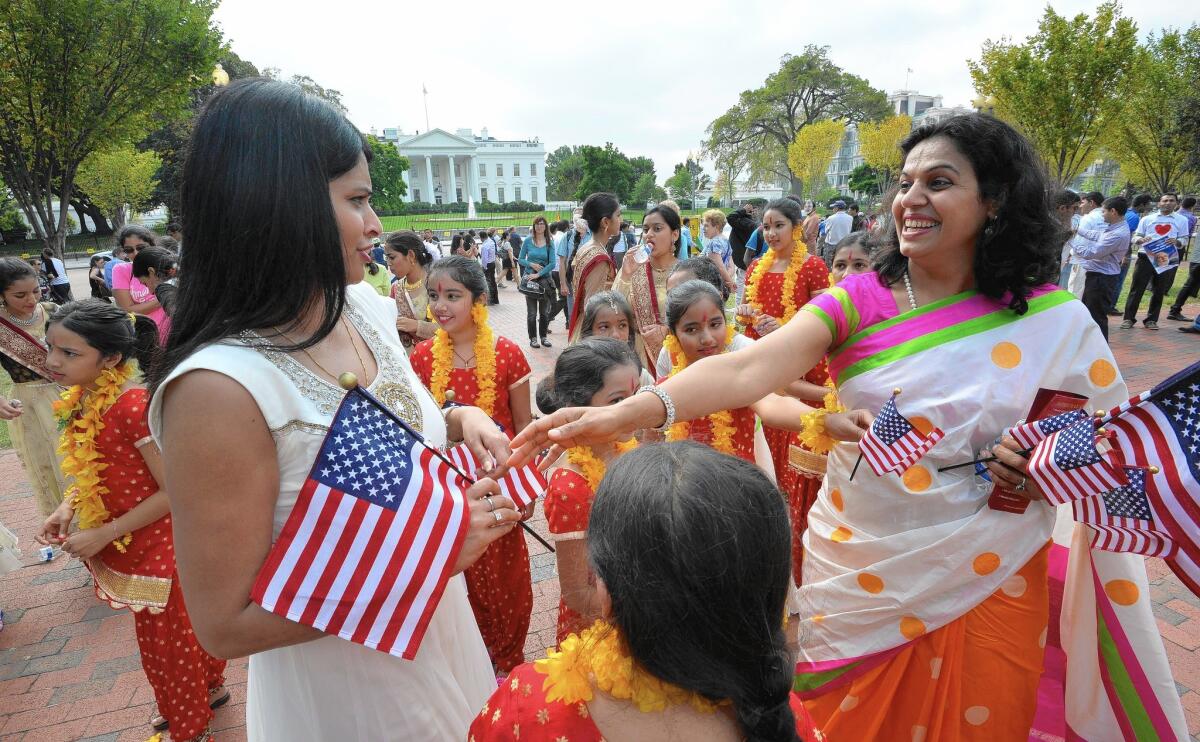Obama, India premier reach agreements on climate change, other issues

- Share via
Reporting from Washington — They never actually broke bread together, but President Obama and Indian Prime Minister Narendra Modi took a small step toward warmer relations Tuesday when they agreed to work together on climate change, one of the most contentious issues facing the countries.
News of a baby-step agreement came at the end of a two-day visit that included a White House dinner at which, because Modi was fasting in observance of a religious holiday, no one really ate.
But in their first face-to-face meeting, the leaders of the world’s two largest democracies bonded over their shared respect for the Rev. Martin Luther King Jr., a kindred spirit of Mohandas K. Gandhi, by taking an afternoon stroll around the MLK monument. Before that, they met for more than an hour in the Oval Office.
At the end of the meeting, the pair announced agreement on a number of issues, including violent extremism, food security and space exploration.
Obama left the climate change announcement to Modi, who told reporters gathered in the Oval Office that he and the president had agreed to “consult and cooperate closely.” Modi called it “an area of strong priority for both of us.”
Later the White House announced that the two men had agreed to launch working groups on climate and energy.
The two nations, which are the world’s No. 2 and No. 3 biggest emitters of greenhouse gases, have clashed over the subject. The U.S. is pushing India and other fast-developing nations to rely less on coal power, even as the Obama administration has struggled to advance its own domestic limits on carbon emissions.
That Modi was the one to make the careful pronouncement was a sign of the care the two leaders are taking as they try to mend years of chilly relations between the countries — and between Modi and the U.S. government.
For the last few years, American business leaders have chafed against restraints the Indian government put on U.S. investment in their country. U.S. officials singled out India for not protecting American intellectual property.
The tension with Modi was more personal. Before he won election by a landslide in the spring, Modi hadn’t been allowed to visit the U.S. for nearly a decade because State Department officials blamed him for failing to control deadly religious riots in 2002 when he was in charge of the state of Gujarat.
After the election, the Obama administration hurried to make amends, dispatching Secretary of State John F. Kerry to New Delhi to talk about ways the two countries might cooperate.
Modi was greeted by enthusiastic crowds when he arrived in New York for the United Nations General Assembly meeting. More than 19,000 people bought tickets to see him at Madison Square Garden, where he appeared alongside Bollywood dancers for a celebration over the weekend.
After Modi arrived Monday in Washington, the White House emphasized the significance of the first meeting between Obama, leader of one of the oldest democracies in the world, and Modi, leader of the biggest. U.S. officials increasingly see India as a valuable partner in fighting global threats such as terrorism and countering China’s regional influence in Asia.
Obama and Modi also agreed to work toward a fivefold increase in trade between the U.S. and India, and to expand defense cooperation. They jointly affirmed the decision to renew for 10 years the 2005 framework for the U.S.-India Defense Relationship, according to a statement released Tuesday.
Analysts and climate activists said the agreements on climate matters reflected a new level of cooperation.
They agreed to strengthen and expand the highly successful U.S.-India Partnership to Advance Clean Energy, which includes a U.S. commitment to a “smart cities” program designed to promote efficient urban energy infrastructure, improve India’s power grid, upgrade India’s alternative energy institutes and develop new innovation centers.
“Prime Minister Modi wants development infrastructure, manufacturing investment, sanitation and ‘smart cities,’” said Richard M. Rossow, Wadhwani chair in U.S.-India Policy Studies at the Center for Strategic and International Studies. “American commitments to help in these areas will be warmly received in India.”
The leaders also broached the difficult subject of hydrofluorocarbons. In a joint statement, India recognized the need to move toward the hydrofluorocarbon phase-out called for under the 1987 Montreal Protocol, an international treaty to eliminate substances that harm the ozone layer. Though environmental advocates never expected India to fully embrace the high standards of the Montreal Protocol so soon, they took Tuesday’s announcements as a step in the right direction.
“That looks like excellent progress,” said Durwood Zaelke, president of the Institute for Governance and Sustainable Development. “These two countries need each other so much, and they will find many points of cooperation. And one of them will eventually be the Montreal Protocol.”
More to Read
Sign up for Essential California
The most important California stories and recommendations in your inbox every morning.
You may occasionally receive promotional content from the Los Angeles Times.














